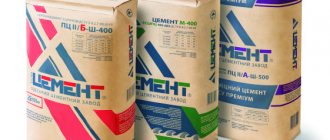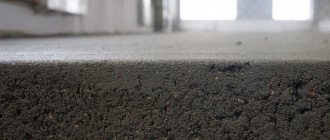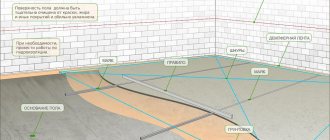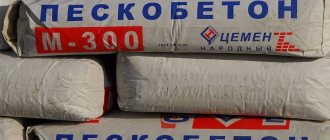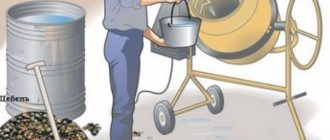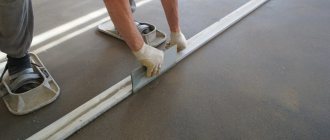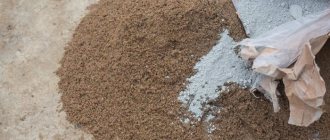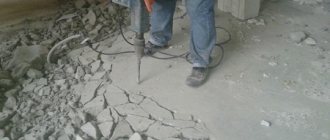Many of us strive to carry out repairs, re-equipment or construction of a house, garage, gazebo on our own, without the involvement of specialists. Some out of savings, some out of interest (I can do it myself!). The work that you can really do yourself includes installing a floor screed, even if you have never done it. But before starting the process, you need to prepare building materials in the required quantity. Let's try to figure out how many kilograms of cement need to be prepared for a floor screed, depending on its area and planned height.
Calculation example for a classic floor screed
Earlier, we already looked in detail at how to fill a garage floor. Before proceeding, for example, to calculating the amount of cement and sand for a floor screed for a specific room, a number of assumptions should be made:
So, how much cement is needed for a floor screed filled with M200 cement-sand mortar (proportions of cement and sand 1:3), based on M400 cement, single-layer, 0.04 m thick for a room 4x3.5 meters?
We calculate the volume to be filled: 4x3.5x0.04 = 0.56 m3. To calculate cement, we use the table of the amount of binder per 1 m3 for mortar grades M150 and M200, based on cement: M300, M400 and M500:
| Cement brand | Brand of solution | |
| M150 | M200 | |
| Cement | Cement consumption per 1 cubic meter m of solution | |
| M500 | 330 kg | 410 kg |
| M400 | 400 kg | 490 kg |
| M300 | 510 kg | — |
As follows from the table, to prepare 1 m3 of M200 grade mortar based on M400 cement, 490 kg of binder (cement) is required. Since we need to prepare not 1 m3 but less - 0.56 m3, we must perform the following arithmetic operation: 490x0.56 = 274.4 kg of M400 cement is required to prepare M200 mortar for pouring a 4 cm thick floor screed in a 4x3 room, 5 m.
Calculation of the amount of sand based on the above proportion of 1 part cement to 3 parts sand (humidity no more than 7%): 274.4x3 = 823.2 kg of sand, required for preparing a cement-sand mortar for pouring a 4 cm thick floor screed in a 4x3 room, 5 m.
In a similar way, you can calculate the number of components for any screed thickness, for rooms of any size - multiply “your” length and width of the room and “your” thickness of the screed layer in meters. Using tabular data, determine the amount of cement, and then determine the amount of sand based on the proportions.
Helpful advice! To increase the wear resistance of the screed, especially important for “finishing” floor screeds, it is imperative to iron its top layer.
The ironing technology is as follows:
Thus, a hard, wear-resistant and very durable crust is formed on the surface of the screed, which reliably protects the screed from abrasion and other mechanical influences.
Source
How much sand is in 1 m3 of solution
50kg - 0.038 m3
in 25kg - 0.019 m3
2. Cement-sand mortar for masonry:
For 1 m2 of brickwork with a masonry thickness of 1 brick, the amount of mortar approaches 75 liters of consumption per 1 m2. If the wall is made of brick with a thickness of 1.5 bricks, then the amount of mortar will correspond to the figure of 115 liters.
3. Proportions of cement mortar:
In order to prepare a mortar, you need: 1 part of a binder (cement) and 4 parts of filler.
4. Proportions of plaster mixture:
You will need 1 part binder (cement) and 3 parts aggregate.
5. Cement mortar for brick:
According to consumption standards, 400 pcs. bricks (more precisely 404) - 1 m3 of masonry. The solution consumption rate per 1 m3 is 0.23 m3 (in practice, 0.25 is accepted).
6. How to calculate the consumption of sand concrete M - 300 per screed?
The approximate density of the sand concrete mixture is 1.7-1.75 kg/cubic dm
For 1m/2 with a thickness of 1cm = 18-20 kg of mixture (sand concrete M300).
7. Tile adhesive:
The consumption of tile adhesive per 1 m2 of laid tiles is 10 kg. dry mixture with a layer thickness of the finished solution of 10 mm.
8. Adhesive for foam concrete blocks and gas silicate blocks:
The consumption of foam concrete adhesive per 1 m3 of laid foam concrete masonry is 40 kg. dry mixture
9. Self-leveling floors:
The consumption of self-leveling floors per 1 m2 of finished mortar is 6 kg. dry mixture, with a recommended layer thickness of 5 mm.
10. Plasters for walls:
The plaster consumption per 1 m2 of finished mortar is 10 kg. dry mixture, with a recommended layer thickness of 10 mm.
11. Wall putties:
The putty consumption per 1 m2 of finished solution is 0.9-1.0 kg. mixtures.
12. Grout (tile joints):
The grout consumption per 1 m2 of laid tiles is 120 g, with a recommended joint thickness of 2 mm.
13. Universal mixture M −150:
The consumption of the universal mixture M-150 per 1 m3 of the finished solution is 450 kg. dry mixture.
14. Masonry mixture M-200:
The consumption of the M-200 masonry mixture per 1 m3 of masonry is 350 kg. dry masonry mixture.
15. Waterproofing material (penetrating layer):
Waterproofing consumption per 1 m2 of surface will require 700 g. dry mixture diluted to a sludge state for application with a brush (roller).
16. Paints:
Paint consumption per 1 m2 of walls or ceilings when first applied to a primed, flat surface is 0.3 liters, the second layer when applied correctly is 0.2 liters per 1 m2.
17. Polyurethane floors:
The consumption of polyurethane self-leveling floor when applied to a dust-removing primer is 1.5 kg per 1 m2 of concrete floor surface, with a thickness of 1 mm.
Amount of cement per masonry (cement consumption per bricklaying):
To prepare 1 m3 of cement mortar you need 8 50 kg bags of cement. and mixed with sand in a ratio of 1:4, where one part of sand is also equal to 50 kg.
19. The consumption of materials (excluding losses) for the construction of 1 m2 of the surface of a brick wall with a thickness of a quarter of a brick is:
cement (for mortar grade M-100) - 5 kg;
cement (for mortar grade M-75) - 4 kg;
cement (for mortar grade M-50) - 2.5 kg.
How much cement, sand, crushed stone in 1 m3 of concrete (how to prepare concrete - proportions):
a) For 1m3 M 150 concrete you will need: 220 kg of cement, 0.6 m3 of sand, 0.8 m3 of crushed stone.
b) For 1m3 M 200 concrete you will need: 280 kg of cement, 0.5 m3 of sand, 0.8 m3 of crushed stone.
c) For 1m3 M 250 concrete you will need: 330 kg of cement, 0.5 m3 of sand, 0.8 m3 of crushed stone.
d) For 1m3 M 300 concrete you will need: 380 kg of cement, 0.5 m3 of sand, 0.8 m3 of crushed stone.
21. Clay-sand mortar. How to cook:
Clay-sand mortar is a 1:3 proportion, where one part clay mortar and three parts vermiculite. The resulting solution is poured in a layer up to 50 mm
To make the clay-sand mortar layer for a warm screed or wall construction even warmer, you need to mix the clay-sand mortar in a 1:1 ratio with sawdust or flooring (finely chopped straw). The prepared solution is poured into a layer 20-30 cm thick.
22. Proportion of concrete and foam chips:
In order to create such a solution, which is mainly used for insulating floors and ceilings of bathhouses, you need to mix 1 part of ordinary cement mortar (or ready-made concrete mortar) and 3 parts of foam chips.
23. How many blocks are there in 1 m3 of masonry?
Size 200×300×600 – 27 blocks per 1m3
Size 200(188)x200(188)x400 - 62 blocks per 1 m3
24. Secrets of brick or block facing masonry, masonry mortar + black seam:
Consumption - 1-1.5 buckets of solution per 1m2. Instead of an expensive plasticizer, 2 caps of cheap shampoo (for plasticity) per batch of 1/4, 1 liter. a jar of black pigment, and in order to avoid efflorescence, 200g. 9% vinegar solution.
25. Penetrating waterproofing penecrit and penetron:
Penecrete 150-200 grams per seam 25×25 mm per 1 linear meter of grooves
Penetron (for 2 layers according to technology) from 0.8 kg - 1.1 kg per 1 m2 depending on the looseness and unevenness of the surface
How many bricks are needed for 1m2 of masonry:
a) If the wall thickness is half a brick - 120 mm
- single brick - 61 pcs. excluding seam, 51 pcs. with seam
- one-and-a-half brick - 46 pcs. excluding seam, 39 pcs. with seam
- double brick - 30 pcs. excluding seam, 26 pcs. with seam
b) If the wall thickness is one brick - 250 mm
- single brick - 128 pcs. excluding seam, 102 pcs. with seam
- one-and-a-half brick - 95 pcs. excluding seam, 78 pcs. with seam
- double brick - 60 pcs. excluding seam, 52 pcs. with seam
c) If the wall thickness is one and a half bricks - 380 mm
- single brick - 189 pcs. excluding seam, 153 pcs. with seam
- one-and-a-half brick—140 pcs. excluding seam, 117 pcs. with seam
- double brick - 90 pcs. excluding seam, 78 pcs. with seam
d) If the wall thickness is two bricks - 510 mm
- single brick - 256 pcs. excluding seam, 204 pcs. with seam
- one-and-a-half brick - 190 pcs. excluding seam, 156 pcs. with seam
- double brick - 120 pcs without seam, 104 pcs with seam
e) If the wall thickness is two and a half bricks - 640 mm
- single brick - 317 pcs. excluding seam, 255 pieces with seam
- one-and-a-half brick - 235 pcs. excluding seam, 195 pieces with seam
- double brick - 150 pcs. excluding seam, 130 pcs. with seam
What is the screed for underfloor heating made of?
proportions for screed also apply , depending on the future use of the floors. The ratio of shares between the components can be as follows - for one share of cement, five shares of sand and water (0.7 shares) are added, if, after hardening, parquet, laminate or tiles will be laid the floor screed solution If soft materials (carpet, linoleum) are used as flooring, then the proportions may be different: cement - 1 part, sand - 4 parts, water - 0.7 parts. When crushed stone is added to the mixture for screeding a heated floor, then the ratio between the components will be as follows: cement - 1 part, sand - 3 parts and 5 parts crushed stone. To prepare such a mixture you will need water, usually up to half the weight of cement. Installing a heated floor screed can be done much easier and faster if you use special ready-made mixtures. How to properly use ready-made mixtures is described in the instructions supplied with them.
General concepts
In order not to make mistakes when pouring cement mortar, you need to clearly understand why the floor screed is needed, what functions it performs, how to prepare the cement mortar, what proportion of the ingredients used should be observed when you make the mortar.
Screed concrete is used as flooring in country houses and apartments.
The main issues that are resolved during the pouring process include:
- Leveling the floor surface.
- Strength strengthening of the array.
- Increasing heat and sound insulation parameters.
- Creating, if necessary, the required floor slope.
- Increasing the height of the cover.
- Preparation for laying utilities (warm floors).
- Uniform distribution of loads.
What requirements must a screed for a heated floor meet?
In addition, this thickness of the screed will ensure the necessary uniform drying. When cracks appear in the screed of a heated floor , this means that this does not promise reliable operation of the electric floor in the future. The reason for this phenomenon is two negative aspects:
Due to the presence of cracks in the floor screed and disruption of the uniform distribution of heat, local areas with elevated temperatures will appear and this will lead to overheating of the heating elements, resulting in a reduction in their service life and rapid failure.
The presence of cracks prevents uniform heating of the floor, and therefore heating of the room. Therefore, an alarming symptom is the appearance of cracks on the heated floor screed, which indicates that the screed was installed incorrectly and calls for timely measures to be taken to eliminate the violations. It is also necessary to note one more important point here. Cement gains strength within four weeks, so during this period it is advisable not to carry out any repair or finishing work, but to wait for the screed to dry completely. To get a high-quality result, after filling, you need to protect the room from drafts and it is best to darken it. To ensure the same drying conditions for the screed throughout the room, these measures must be taken. After a day, the screed can be covered with plastic wrap and wait for the solution to completely harden.
There are several well-known independent types of screed for heated floors:
The latter type of screed is now widespread, especially when renovations are being carried out in old houses. Its main advantage is that it is performed very easily and quickly. After several hours of drying, you can already start working with it, whereas the wet type of screed requires a month to dry completely. You can lay a heated floor on a dry screed, because it is all made from dry materials. This approach makes it possible to reduce the time required to create a heating system. The manufacturing technology of this type of screed is quite simple. Polyethylene film or other vapor barrier materials are initially laid on the floor. Fine dry bulk material is poured over the film, for which the following materials can be used: perlite sand, quartz sand, fine-grained slag, then this material is leveled and compacted. Sheet material is laid on top - plasterboard, chipboard, waterproof plywood and other similar materials. These sheets are fastened with self-tapping screws, and the seams between the individual sheets are puttied and sanded. Then the resulting surface is covered with bitumen waterproofing and after it has completely dried (after twelve hours), the necessary repair work can be continued.
Conclusion: thus, the screed is considered an indispensable and main attribute in the process of creating a warm floor. And even if the installation technology does not provide for a screed, it may be required to level the floor surface. Do not forget about the main point that any work on creating a floor heating begins with leveling its surface.
Source
General concepts
In order not to make mistakes when pouring cement mortar, you need to clearly understand why the floor screed is needed, what functions it performs, how to prepare the cement mortar, what proportion of the ingredients used should be observed when you make the mortar.
Screed concrete is used as flooring in country houses and apartments.
The main issues that are resolved during the pouring process include:
- Leveling the floor surface.
- Strength strengthening of the array.
- Increasing heat and sound insulation parameters.
- Creating, if necessary, the required floor slope.
- Increasing the height of the cover.
- Preparation for laying utilities (warm floors).
- Uniform distribution of loads.
How to calculate the amount of cement and sand for floor screed?
Filling a floor screed in an apartment or industrial premises is a mandatory procedure. The finishing coating is laid on the leveled base or it is used without finishing as a working surface for industrial production. Before deciding how to calculate the amount of cement for floor screed, you need to find out the purpose of the room and the expected load on the concrete base.
One of the main criteria in preparing a solution for pouring a base is its thickness. It should be remembered that reinforcement with metal mesh is carried out with a minimum base thickness of 20 mm, a maximum pouring height of 40 mm, this is the thickness most often used for flooring in civil housing construction.
The next important point for calculations is the grade of cement. To organize the base, cement grades M300, M400, M500 are used. As a result of mixing with sand and water, a cement mortar with a value of M150 or M200 is obtained.
The brand of the mixture is determined based on the planned load on the base. Thus, M200 can be used to organize foundations in industrial buildings, for example, in garages, and the strength of the M150 grade is sufficient for pouring screed in an apartment.
To carry out calculations, it is necessary to know the rate of cement consumption to obtain a solution of a certain brand. So, to obtain one cubic meter of M150 grade mortar, you will need 330 kg of M500 cement or 400 kg of M400 cement. To obtain the same volume of brand M200 solution, you need to purchase 410 kg of M500 cement or 490 kg of M400 cement.
Let us calculate the organization of a base 40 mm thick for a room of 30 sq.m. in two versions: for mortar grade M150 and for grade M200 using cement grade M400. Calculation procedure:
To carry out screeding work in an apartment, river sand is used; for industrial premises, sand from quarries is chosen.
This model for calculating cement consumption for floor screed is applicable for any area and thickness of the mixture layer. To obtain the area of the room, multiply the length and width of the room.
If the room configuration is complex, it is best to use the floor plan and calculate the area, referring to the paper. Thus, taking into account the ratio of 1:3, it will be possible to determine how much cement and sand is needed per cube of screed mortar.
What does consumption depend on?
The calculation of cement mortar for pouring screed depends not only on the grade of concrete that is planned to be obtained, but also on other factors. The above were idealized calculations, but in real life various changes and amendments arise:
- Examples of how to calculate cement for screed are valid for fresh cement, but if the work is carried out using material produced more than six months ago, the strength of the concrete used will be significantly lower. Therefore, the volume of cement in the mixture is increased by 10-15%;
- If the measurements of the height of the future screed were determined incorrectly or there are significant defects in the base, the volume of the cement-sand mortar may increase to 50% of the calculated volume;
- To save on screed production, as well as to ensure the thermal insulation properties of the base, additives can be used in the mixture of large fractions, and the thickness of such a screed can reach 10 mm. Typically, expanded clay, shungizite or crushed stone are used as additives, but such materials significantly change the properties of concrete and can affect the durability of the screed;
- When placing communications at the base of the screed, a change in volume occurs, which affects the amount of materials for preparing the solution for pouring the screed;
- The amount of material used depends on the brand of cement used and the required strength of the resulting mortar;
- When pouring some rooms, there may be a requirement for organizing the slope of the screed; in this case, there is also a change in the volume of the solution and the materials for its manufacture.
Source
For dry mixture
When using dry and semi-dry mixtures to organize screed, it is necessary to take into account the characteristics for each specific mixture, which can be found on the packaging. Usually indicate the volume of the mixture to cover one square meter of the base with a layer of 1 mm. For example, to obtain a solution of grade M100 sufficient for use indoors in residential premises, the manufacturer of semi-dry floor screed recommends the following consumption:
Taking into account the above data, you can calculate the required material for 30 square meters with a screed thickness of 40 mm.
It is necessary to multiply the area by the consumption of the mixture by 1 m2 and by 4 (since the planned thickness of the screed is 4 mm, and the calculation is given for a thickness of 1 mm). We get: 30x2x4 = 120 kg, while the volume of water required: 120 kg x 0.22 l = 26.4 liters.
(function(w, d, n, s, t) w[n] = w[n] || []; w[n].push(function() Ya.Context.AdvManager.render( blockId: "RA- 510923-1", renderTo: "yandex_rtb_R-A-510923-1", async: true >); >); t = d.getElementsByTagName("script")[0]; s = d.createElement("script") ; s.type = "text/javascript"; s.src = "//an.yandex.ru/system/context.js"; s.async = true; t.parentNode.insertBefore(s, t); >) (this, this.document, "yandexContextAsyncCallbacks");
For traditional solution
The traditional calculation of building materials for the production of ordinary cement-sand mortar is carried out in cubic meters, so for ease of calculation it is necessary to convert cubic meters into kilograms.
For example, for an area of 30 sq.m. and a screed thickness of 40 mm will require 1.2 m 2 of solution. In this case, the volume of cement will be one-fourth of the total volume, and sand - three-quarters.
As a result, to obtain 1.2 m 3 of solution, you will need 0.3 m 3 x 1400 kg = 420 kg of cement and 0.9 m 3 x 1625 kg = 1463 kg of sand.
The required volume of water to obtain 1.2 m 3 of solution is calculated at the rate of 0.4 liters per kilogram of dry components, which is (420 + 1463) x 0.4 = 753 liters.
Types of screeds
- Cement-sand. Used to level the surface for finishing: parquet, linoleum, boards, ceramic tiles, porcelain stoneware and other types of finished flooring. When strengthening the surface with iron and subsequent painting, it can be used as a finishing coating, suitable for technical rooms and rooms with high humidity.
- Self-leveling screed. For the construction of this structure, ready-made packaged material produced industrially is used. The screed can be used as a base for a finished floor and as a finishing coating.
- Dry screed. It is also equipped with special hard materials. This type of screed is capable of leveling out small unevenness. It is performed using special technology, so it is best to order such a screed from experienced specialists.
Despite new construction technologies, the cement-sand option for arranging the base of the floor is the most common and accessible for self-construction, so we will dwell on this option in more detail: the thickness of the screed, the proportions of cement for the floor screed, calculating the number of components, how to reinforce floors with cement and other practical questions.
Screed solution.
The screed solution is prepared from the following components:
— cement grade M400 (it is necessary to use only fresh cement, since the grade of cement decreases during storage);
- sand. It must be dry, and to remove debris and stones, it must be sifted;
— fiber (polypropylene fiber);
- plasticizer (improves the properties of the solution).
The proportions of the screed solution primarily depend on the brand of cement used. Online calculation of the composition of cement mortar. The proportions are indicated in the table, where the brand of mortar is indicated on the right, the brand of cement on the left, and their proportions in the middle:
It is not recommended to use a grade of mortar for floor screed below M150; the most commonly used grade is M200.
Information on the purpose of the calculator
The mortar calculator is designed to calculate the proportions and composition of cement-sand and cement-expanded clay mortars, select the required mobility and calculate the cost.
When filling out the data, pay attention to the additional information with the Additional information sign
Construction is an area in which it is impossible to do without cement mortar. The strength of the mortar depends on what brand of cement you use, the sand fineness modulus and compliance with hardening rules. The mortar must be used no later than 30 minutes after preparation.
Method for preparing mortar.
Sand and dry cement are mixed in the required proportions, and gradually poured in portions with water until the required mobility is obtained. If necessary, the calculated amount of plasticizers is initially diluted in water. To avoid the solution sticking to the walls of the concrete mixer, water must be poured into the mixture in small portions.
The required brand of solution depends on the brand of materials used. For example, when masonry with a brick grade of M100, it is necessary to mix a mortar of the same grade. To prepare a mortar for the base of the foundation, you can use a mortar of lower strength than the strength grade of the foundation. To calculate the required grade and mobility, use the calculator for selecting the composition and proportions of the mortar.
The calculation of the composition of mortars is carried out in accordance with SP82-101-98: “Preparation and use of mortars” and GOST 28013-98: “Building mortars. General technical conditions".
For more comfortable work with cement mortars, it is necessary to use plasticizers, or ordinary detergents for household work. They help achieve plasticity of the solution and simplify the mixing process. The choice of plasticizers is quite large; you need to choose the most suitable one for your conditions, for example, in cold weather you need to use plasticizers with antifreeze additives.
For laying bricks and building blocks, there are “warm” solutions with the addition of heat-saving binders, such as expanded polystyrene, expanded clay and perlite sand. Such solutions prevent heat loss through “cold bridges” and make the wall more monolithic in its properties.
An important parameter is the mobility of the solution. It is necessary to select exactly the one that matches the type of work. Approximate table of mobility of mortars:
- P1 – laying rubble stones using the vibration method
- P2 – ordinary masonry of rubble stones; Installation of walls and jointing in walls made of large panels and blocks
- P3 – laying of hollow and solid bricks, building blocks; filling voids of rubble masonry
- P4 – Plastering works
- Lime mortars - Their strength is less than that of pure cement mortar, however, they are warmer and have greater ductility. For production, lime paste, ground quicklime and sand are used.
- Cement-lime mortar - It contains cement and lime paste. It is very plastic and has high strength, can be used for almost any type of masonry.
- Cement-sand mortar - It is based on cement and sand. This mixture without plasticizers is quite rigid and also inactive.
The following is a complete list of calculations performed with a brief description of each item. If you haven't found the answer to your question, you can contact us via feedback.
Screed solution, mixing its components.
Dry and liquid elements of the composition are mixed in different containers. The instructions for preparing the screed solution consist of the following steps:
— First, the dry components (sand, fiber and cement) are mixed, which must be mixed for 5 minutes. M400 cement is mixed with sand in a 1:3 ratio; if you take, for example, 50 kg of sand, you will need 16.7 kg of cement.
— The plasticizer and water are mixed in another container. About 190 g of plasticizer is consumed per 50 kg (bag) of cement. A third of the water from the mass of cement is added, this means that 5.6 liters of water will be needed (taking into account that the plasticizer will account for 0.6 liters) per third of the bag of cement.
— Then the liquid and dry components are mixed; for this, the dry mixture is gradually poured into a container with liquid, and it must be thoroughly stirred. If you immediately pour water into a dry mixture, lumps will form, which are then difficult to stir. Manually mixing the screed mortar is long and difficult; it is best to use a construction mixer or a drill with an attachment.
The finished screed solution should be viscous, although it is much more difficult to work with, but there will be fewer cracks on the surface. To prevent cracks from appearing as the coating dries, the surface should be moistened with water every day.
Breeding rules
Installation of cement-sand screed
How to dilute cement for large volumes of finishing is of interest to any owner. To do this, use a concrete mixer, and for small ones, a construction mixer or a special attachment for a drill.
The process of mixing the mortar occurs as follows: first, dry components are placed in a container and mixed until the composition is homogeneous, then the required amount of water is poured. The water in the composition is equal to an average of 0.8 units of the amount of cement. Mix the components at low speed for 5-10 minutes until there are no lumps left.
It is important to remember that you can only work with the resulting mass for a maximum of 1.5 hours, otherwise it will harden. When using human labor for kneading, you should calculate the volume of the trough for 10–20 buckets
It is convenient to mix after adding every two buckets of sand. This speeds up the process and leaves no lumps
When using human labor for kneading, you should calculate the volume of the trough for 10–20 buckets. It is convenient to mix after adding every two buckets of sand. This speeds up the process and leaves no lumps.
Preparation and use of lime-cement mortar
Liquid soap or dishwashing liquid (for example, Fairy) is often added to standard solutions for plasticity. Its volume per concrete mixer should be no more than 100 grams. This material is more pliable and dries slower.
Particular attention should be paid to the quality of the sand. When laying or plastering, use only sifted, washed sand without pebbles.
Its moisture content during kneading will affect the amount of water added. Only if the sand is dry should you add all the water according to the recipe. If the sand is wet, you need to add water gradually, checking the consistency.
Calculation of the amount of mortar for screed.
First, you need to find out the required volume of building material; to do this, you need to multiply the coverage area by the thickness of the future screed. For example, if the floor area is 40 m², and the thickness of the screed layer is 5 cm, then we get: 40 * 0.05 = 2 cubic meters of solution.
Then you need to calculate the amount of cement and sand. Since the screed solution is made in a ratio of 1:3, this means you will need 0.5 cubic meters of cement and 1.5 cubic meters of sand. A cubic meter of cement weighs approximately 1300 kg, which follows: 0.5 * 1.3
In this way, you can calculate the consumption of mortar for floor screed for a certain area, which will allow you to prepare the required amount of building material in advance.
Source
Preparation for DSP consumption
The screed solution is prepared by adding water to the bulk substances. Most often, builders prepare the composition directly on the site, but you can purchase a ready-made composition (it is more expensive).
In addition to the presented components, the factory mixture contains plasticizers and other additives. Thanks to them, the solution becomes homogeneous. Some brands can be used at low temperatures, because they contain frost-resistant substances.
For better adhesion of the components, it is recommended to mix the solution by hand. The standard ratio of sand to cement is 1:3. In some cases, other proportions are used (1:2 or 1:4).
When calculating the amount of materials per 1 m2, it is possible to determine with great accuracy the brand and quantity of the substance. You can replace one type of composition with another, without deteriorating the quality of work.
Screed calculation.
In order to level the floor, a cement screed is often used, but in order for everything to be successful, it is necessary to calculate the screed . If you do everything correctly, you can save your money, because all the purchased material will be used. But only a few know how to correctly calculate the screed . Next, we will tell you about all the intricacies of correct calculation of the screed, which will help make your floor perfectly flat, and at the same time save a lot.
Solution distribution.
The solution for the rough base must be distributed over the floor so that the floor becomes perfectly level. This rule must be observed, because there are often cases when the solution is poured not only with unevenness, but also with the wrong slope. Remember that after the screed has dried, it may greatly decrease in size, and you may discover new surprises in the form of the fact that it has dried unevenly. Because of this, the floor begins to crack and peel. In order to avoid this situation, experienced people use water; they moisten the problem areas well with it.
Start
Since the height difference is quite large, the choice fell on a cement-sand screed, because self-leveling floors, according to my calculations, would cost 70+ tr. (and the work would only cost 15-20 thousand rubles).
The main difference was in the corridor. Apparently the floors were poured in several stages.
The door sill was successfully chipped using a hammer drill and a hammer.
Construction of the screed began with thorough cleaning. First dry, then wet. For better adhesion of the slab to the future screed, the entire surface was generously treated with Betonkontakt.
A kind of damper tape was glued along the entire perimeter, which, after the screed hardened, was cut off with a utility knife. The tape will prevent cracks when the building shrinks. I went to many stores and never found it. I had to take something like a backing for the laminate (Izolon, I think) 5 mm thick and cut the roll into 10-centimeter rings. I glued it with masking tape, it didn’t stick well
Fastening the reinforcement mesh
They decided to make a reinforced screed, because in some places its thickness was only 3-3.5 cm. It seems that according to SNiP, a screed with a thickness of more than 5 cm does not need to be reinforced. Someone said “it will do without a net,” but to calm down he decided to put it on. We do it for ourselves
I used a regular masonry mesh with 50*50 cells. Later I realized that it was better to take a chain-link type roll, because... it would be much more convenient for transportation (though more expensive). To attach the mesh to the base, we used these dowel wedges. Drilled, inserted, hammered. Very comfortably. It took about 200-300 pieces for the apartment. It’s better to buy in boxes of 100 pcs, it’s several times cheaper compared to packs of 10 pcs.
The meshes were overlapped by 1 link. When drilling holes, 4 drills (6 diameter) for a hammer drill were burned on the reinforcement. The first two were Chinese, 3 pieces per room. The last German one lasted longer, but also cost 2-3 times more.
In addition to the fastening, 3-4 more points were made along the contour. The beacons were set using a laser level.
Screed thickness.
If you want a heated floor, use a screed with a thickness of 40mm, for electric heating the thickness is increased by 10mm - that is, 50mm, and if you decide to do water heating, then you need to make a screed with a thickness of 70mm to 100mm. When calculating the screed, be sure to pay attention to the thickness.
According to SNiP rules, the minimum thickness for a screed is 40mm, but there are rooms that do not require increased heat, such as storage rooms, hallways and other similar rooms. In such rooms it is allowed to use a screed with a height of 30mm, but in no case lower, because the durability and strength of the screed will obviously decrease.
To make the room soundproof better, you need to fill the solution twice. The first layer is 20mm, and the second can be more than 20mm. Between these screeds, it is necessary to put insulation, or any other material for sound insulation, and a special film must be placed on top of the screeds.
How many bags of cement to buy
To understand how many bags of cement will be needed to prepare the mixture, use proportions and volume. So, if you prepare a batch for floor screed and use a ratio of 1:4, it turns out that you need a quarter of a cube of cement. The bulk density of the binder shows that a liter contains 1.4 kilograms.
Binder consumption can be calculated differently. So, if the thickness of the screed is 10 centimeters, then for one square you need 0.1 cubic meter of solution. It contains 10 times less cement than a cube: 350 kg / 10 = 35 kilograms. For a screed 5 centimeters thick you need 35 / 2 = 17.5 kilograms of cement.
It is worth remembering that the rate of cement consumption also depends on the activity of the binder. It is usually determined experimentally, during the process of mixing control samples, and during strength testing. But this cannot be done on site, so you should focus on the shelf life of the material. The fresher the better, since over time cement can lose up to 20% of its activity per month. After keeping bags of M500 cement in the warehouse for about three months, you can already work with the M400 brand.
Concrete prepared using technology and with the correct consumption of cement is able to withstand all loads, demonstrate optimal parameters and properties, guaranteeing the durability and reliability of structures.
Composition of floor screed.
For proper screeding, it is necessary to study the components and consistency of the solution in advance. The screed should contain not only cement, water and sand, but also various other additives that are designed to perform specific functions. For example, you can add polystyrene granules or expanded clay to your solution; this, in turn, has insulating properties. Whatever filler you choose, always remember that the ratio of cement and filler is 50% to 50%. But only to cement!
Determination of level.
To correctly calculate the screed , you first need to set the zero level. To do this, you can use a water level or a laser device: a level. It must be moved around the room and fixed with marks, which must then be connected with a line. This is the only way to achieve the correct horizontal plane.
From the resulting line, that is, from the zero level, it is necessary to measure the distance. All measurements should be recorded to determine the maximum height. The smallest value is the highest point, the largest value is the lowest point. Using the data obtained, it is necessary to calculate the height of the screed . For example: the greatest height is 1 cm, the smallest is 0.7, it turns out that the difference between them (1 – 0.7 = 0.3) is the average thickness, which must be taken into account. The screed layer is 3cm, which means 3 + 0.3 = 3.3. Conclusion, you should buy the mixture at the rate of 3.3 cm per width.
Nuances when calculating the DSP
To determine the amount of mixture for floor screed, all components are taken into account. The final result is influenced by the correct ratio of substances.
When consuming cement for a screed, some factors are taken into account:
- A technical room (floor in a storage room or garage).
- A preliminary layer with a thickness of 8 cm. The best option is a concrete mixture with a coarse fraction. It is recommended to use sand-cement mortar.
- The final version, intended for further cladding with decorative elements. The thickness of the coating ranges from 5 to 30 mm.
Preparatory activities include a set of actions:
- Clear the room of everything unnecessary using a vacuum cleaner, hard broom or brush. If necessary, the previous coating is removed.
- The damage is being assessed. Large cracks are treated with putty so that the composition does not leak through them. You can use foam for installation work.
- The floor is being marked and beacons are being installed. The zero level is set at any point in the room. Special tools are used for this purpose. The premises are marked from the specified point.
- All marks are connected. In this way, the line of height difference is established. This indicator should be in the range from 5 to 8 mm. If there are large differences, the surface must be leveled, otherwise the composition will crack.
- Taking into account the measurements of the height difference, the final layer thickness is determined.
Before applying the layer, it is recommended to thoroughly moisten the base with water. The best option is to work in pairs: while one is leveling the screed, the second is preparing a new composition.
Filling begins from the corner located on the opposite side of the door. After this, the surface is leveled. For the next 12 hours, a polyethylene film is applied to the base. After the specified time, you can start mashing.
Before determining the consumption of a substance per 1 m3 of solution, the technical characteristics of the material should be taken into account. Some brands of dry matter require large amounts of sand. At the same time, the concentration of cement itself decreases. A screed made with inaccurate calculations may not withstand the predicted load and will quickly collapse.
Calculation of the required amount of mixture.
Each package contains information about the average consumption of the mixture, and this must be taken into account. Suppose we need to fill 20 mm of screed for the entire volume, the consumption is 2 kg per sq.m. with a thickness of 1 mm. Therefore, you need to multiply 20x2 = 40, that is, 40 kg per 1 sq.m. The next thing is to calculate the correct amount of mixture for the entire area of the room: 40x20 (area) = 800 kg. Most often, dry mixtures are packaged in bags of 50 kg or 25 kg, so 800 must be divided by 50 (or 25) to obtain 16 (32) bags of mixture.
Calculation of the amount of material and proportions
So it is necessary to take into account the quality and strength of the material (both the mixture and the brick). Using basic standards, approximately 250 kg of M100 mixture should be used per 1 m3 of wall.
If you prepare the solution yourself, then the proportion should be 1 to 4. Liquid should be added to the CPS, which is usually half the total weight of the mixture.
Calculation for masonry
Regulatory documents contain detailed recommendations and the relationship between wall thickness and the amount of mortar used.
Examples are presented based on ordinary bricks and the required quantity per 1 m3:
- wall 12cm - 420 bricks and 0.19 m3 of mortar;
- wall 25cm – 400 bricks and 0.22 m3 of mortar;
- wall 38cm – 395 bricks and 0.234 m3 of mortar;
- wall 51cm – 394 bricks and 0.24 m3 of mortar;
- wall 64cm - 392 bricks and 0.245 m3 of mortar.
Calculation of material costs for floor screed.
When purchasing screed materials , do not forget the fact that the solution decreases in volume as it dries. Calculating material consumption is absolutely simple, you just need to use several formulas. Let's say you need to make a screed in a room with an area of 20 sq.m., and the thickness of the screed should be 25mm. You need 20x0.25+0.5 cubic meters of solution. Since cement is mixed with sand in a ratio of 1:3, it is possible to calculate the amount of each. To do this, you need to divide 0.4 by 4, where we get 0.125. We multiply this resulting number by 3. And we find that we need 0.125 cubic meters of cement and 0.375 sand. If it doesn’t suit you or you don’t like the calculation in cubic meters, you can convert the data to kilograms. We know that 1 cubic meter of cement is equal to 1300 kg, we get: 0.125x1300 = 162.5 kg of cement.
Now you know the correct calculation of the screed , just do not forget that the solution decreases in volume as it dries, and that is why buy material with a small but reserve.
There is another way to calculate the screed . To do this, you need to calculate the amount of dry cement mixture. By and large, the average density of cement screed is 1800 kg per cubic meter. Therefore, if you do not need to add fillers, then this type of calculation is very easy. The area of the room must be multiplied by the thickness of the screed. After determining the volume, it is necessary to calculate the dry weight of the solution that we need.
If you do add filler, then subtract the amount of additive from the total volume, and then you can convert it to dry weight.
Cooperation with AlfaCem
Any type of composition can be prepared by purchasing building materials from our company. Leave a request with the necessary products through the website, or call us directly to discuss the details of the order.
Competent managers promptly respond to every request. If this article and the attached links do not help you, then representatives of AlfaCem will be able to answer any question. After receiving the product, leave a comment about how you enjoyed working with our company. We will also welcome constructive criticism to improve the service. Waiting for you!
© Online store of building materials "AlfaCem" 2001–2021



